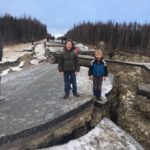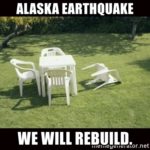Earthquakes, coffee, and fantasy novels…
As I sit here on a quiet New Year’s morning, sipping a wee bit o’ coffee and pondering the last few months, I can’t help but think of the recent earthquake that rocked our community.
On November 30th, a 7.0 earthquake struck south-central Alaska where I make my home. It was the biggest earthquake in the area since 1964, and certainly the biggest I had ever experienced in my lifetime. There I was, heading to work when the rocking began. I slowed the vehicle, convinced that I had a flat tire. When I came to a stop however, the rolling sensation continued. Flat tires don’t do that, and I had never felt an earthquake so strong that I could notice it while driving.
Uh oh.
I looked about to see little change in the homes on either side of the street, but when I turned on the radio, I heard reports of collapsed roads, a freeway offramp, and multiple vehicle collisions. It was going to be a long day.
What had begun with fear seemed to resolve fairly quickly, with Alaskans pulling together and helping one another endure what had been a crushing blow to infrastructure, the loss of some homes, but gratefully, little threat to human life. Indeed, not one serious injury was reported, and zero deaths. In the aftermath, the quake seemed to have brought these hardy people together rather than fracturing them, as is often expected from natural disasters. Alaskans seemed to embrace the event, making memes, taking selfies as they surveyed the damage, and treating a certain highway collapse more as a theme park than as a loss.
Times like this call for reflection. When faced with calamity, how do we respond? Why do some people collapse under the pressure, and others thrive with the challenge? How do we each respond in times such as these, when we are forced outside our comfort zones, and how can we prepare ourselves to do better?

When digging into one’s imagination to craft a story, it is questions such as these that authors consider in an effort to foster character growth. In truth, basic story structure often involves a writer finding ways to believably compel changes in the protagonist as the story develops; an engaging story must have conflict and growth in the main characters as part of the core plot-line.
In Looking for Dei, much of the character development follows calamity. Nara Dall, the protagonist, has good intentions as she tampers with forbidden magic, unleashing chaos and forcing her to flee her village and embark on a perilous journey. As with many circumstances in real life, as Nara experiences catastrophe, the pain often gets spread about a bit, and others suffer as well. Yet, as in Alaska, Nara’s friends and family surround her to share the burden as they move forward in care of one another.
Egads, I tarry. I had planned to write this morning, but had not intended to write a blog post. Perhaps last evening’s aftershock is having an effect on the direction of my thoughts. I think I will finish this coffee and get back to working on book two. Much to do. Much to do. Thanks for checking in!
-David


